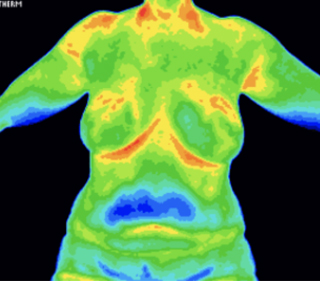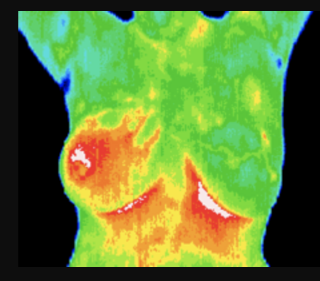A Normal Breast Thermogram

Abnormal Breast Thermogram

Breast Cancer Screening using breast thermography and breast imaging
At Optimal Wellness MD, we recognize the importance of regular screening for breast cancer in all women and in particular those women who have a higher personal risk or family history. Breast imaging is part of our evaluation of women who are contemplating hormone replacement therapy. We recommend using mammography, MRI, ultrasound, and thermography as appropriate.
Where should I go for my thermogram?
We have evaluated the thermography centers in our area and have relationships with several to which we can refer you for breast thermography. Your scan will be generated with reliable equipment performed by a skilled technician and read by a board-certified radiologist. This is very important, since when detecting breast cancer, your thermogram must be done correctly and read by a trained radiologist in order to get accurate information.
How is a breast thermogram done?
Breast thermography involves standing in front of a special camera to measure the small variations in temperature of the skin of the chest, armpits, and breasts.
What does the breast thermogram show us?
Breast cancer or pre-cancerous changes will show as a “hot” or “red” area; normal breast tissue is green to yellow. Thermography can give an estimate of overall breast health, hormonal balance, and suggest the presence of breast cysts or fibrous tissue or other abnormalities.
Is a breast thermogram uncomfortable?
There is no discomfort at all with a thermogram, no squeezing of the breasts and no radiation exposure.
How useful is a breast thermogram?
Breast thermography is extremely sensitive for changes in heat and blood flow in the breast but it is not the same as a mammogram, which looks for micro calcification in the breast tissue, suggesting cancer and therefore does not completely replace the need for mammograms. It is very a sensitive test, detecting up to 90% of breast cancers on it’s own, but may also generate “false positive results” which then may require further testing such as a mammogram, ultrasound or MRI to determine the cause of the abnormality. When combined with a mammogram, 95% of breast cancer is detected at an early stage when it is curable. Breast thermography is best viewed as a complement to mammograms and a screening tool with no downside, and is an evaluation of overall breast health. Because it can detect precancerous abnormalities, breast thermography gives us a chance to intervene and improve your hormonal health and lifestyle factors and thus improve your breast health before an actual cancer can develop.
How do I decide on whether to do a breast thermogram or another imaging test?
The decision of which test to do to screen for breast cancer should always be made though a discussion with your physician weighing your personal health risks, your health history, and the potential risks or benefits of the test.
Reference
Conclusion
“Thermography does not provide information on the morphological characteristics of the breast, but it does provide functional information on thermal and vascular conditions of the tissue. These functional changes are hypothesized to change before the onset of structural changes that occur in a diseased or cancerous state. It is known that physiological changes in tissue precede pathological changes,and studies support thermography’s potential role in the early detection of breast abnormalities that may lead to cancer. Since the late 1970s there have been a number of studies that have tested the effectiveness of this modality. If abnormal, thermograms are early indicators of functional abnormalities that lead to breast cancer, then there may be opportunities for early intervention to reverse the abnormal function toward normal. There is no one screening tool currently available that provides 100% predictability of the presence of a cancerous tumor. The only definitive diagnostic tool is a biopsy. In the past 30 years there have been numerous studies that have demonstrated thermography to have the ability to detect breast abnormalities that other screening methods may not have identified. The Ville Marie study demonstrated that thermography alone had a sensitivity of 83% in detecting breast cancer, while the combination of mammography and thermography had a 95% sensitivity. In light of developments in computer technology, and the maturation of the thermographic industry, additional research is required to confirm and/or continue to develop the potential of this technology to provide effective noninvasive early detection of breast cancer.”


